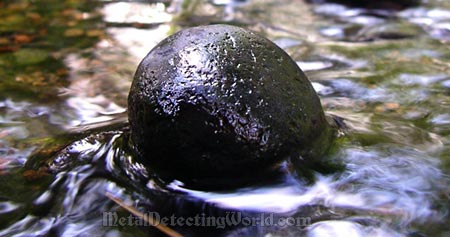Hot Rocks, page 2
NEGATIVE Hot Rocks
(...CONTINUED from previous page)
How To Identify False-Metallic Audio Responses To Negative Hot Rocks,
How To Use Positive Offset To Compensate Intense Non-conductive Ground
Large Negative Hot Rocks at shallow depths are easy to identify by ear because the detector's false-metallic audio responses to them have the following indicative characteristics:
- a distinct character of sound, which makes the negative hot rocks hard to confuse with audio responses to the real non-ferrous targets. The hot-rock signals sound "smudged" - i.e. overextended and with "blurry" edges, and do not sound as "solid" and "accentuated" as audio responses to coins, gold nuggets and meteorites lying at relatively shallow and medium depths. Once you hear that "hollow" and "broad" signal, from this moment on, you will be able to easily distinguish such a signal from any audio responses to real targets.
- a noticeable delay between a "nulling" of the audio Threshold, that comes first, and then a positive response that follows. First, as the center of the search coil passes over the negative hot rock, the Threshold hum momentarily disappears. Then, as you move the coil off the negative hot rock, you hear the "smudged" signal. Some oversized negative hot rocks may generate a double-beep signal which is actually the "positive - nulling - positive" succession.
Besides the sound characteristics of audio responses, here are some additional "symptoms":
- The negative hot rocks will only sound off in one direction, i.e. their signals are not repeatable. In other words, a signal will be heard when moving a search coil in one direction (e.g. left-to-right or right-to-left) over the hot rock, but not in the reverse direction.
- The negative hot rocks are impossible to pinpoint. If you hardly get any consistent audio response or do not get any at all while pinpointing, there is indeed a negative hot rock under your search coil. Also, depending on a metal detector you use, when the negative hot rock is pinpointed, it may give a pulsating signal.
- In most cases, VDI values corresponding to the negative hot rocks do not appear on a display even when the generated signal is strong.
If your detector is operated in the Motion Discriminate search mode, and the detector's Operating Depth Range (Detection Depth) depends on the properly adjusted Manual Ground Balance (in All-Metal mode), entering an area with more intense non-conductive ground can negatively affect your detector's Depth Penetration ability resulting in reduction of the Detection Depth. Conventional Discrimination, if implemented, also contributes to missing deep valuable targets in the high-mineralized ground.
In such a situation, if you use the Non-Silent Search type metal detector, and you are metal detecting in the All-Metal mode of Discrimination, you will notice a "drop" in the Threshold tuning level and should re-balance your detector. Significant changes in the highly non-conductive mineral intensity along with deep negative hot rocks may "null" the Threshold audio in the All Metal mode depending on their intensity. Nothing else can null the Threshold and negatively affect the Ground Balance tuning in the All Metal mode of Discrimination.
To lessen this negative effect, readjust the Manual GB control until a slight increase in audio Threshold is heard while lowering the search coil toward the ground. This adjustment is called a Positive Offset to the Ground Balance. The Positive Offset helps compensate for any sudden decrease in Threshold level.
If you use the Silent-Search type metal detector, you will not notice any change in performance unless you encounter a large negative hot rock lying at moderate or shallow depth. Because the large and oversized negative hot rocks can cause drastic changes in non-conductive mineral intensity, they cause metal detectors of both the Non-Silent Search and Silent Search types to respond with the metallic-like audio responses (the greater the change, the louder the signal) described above.
